The Irish BVD Young Stock Check Test Pilot 2022: Outcomes
Maria Guelbenzu LV PhD MRCVS, Programme Manager, Animal Health Ireland, and Jonas Brock BSc MSc PhD, Assistant Programme Manager, Animal Health Ireland highlight some key outcomes from the Irish BVD Young Stock Check Test Pilot 2022
Two main diagnostic approaches are usually adopted within bovine viral diarrhoea (BVD) control programmes. One focuses on the identification of persistently infected (PI) animals with high levels of viremia for removal from the herd. This is done through direct diagnostic methods targeting the virus or antigen at animal level, as it has been applied to date within the Irish BVD eradication programme. The other focuses on surveillance at herd level, usually applying indirect diagnostic methods that target antibodies to the virus as transiently-infected animals that have been in contact with PIs will develop high levels of long-lasting antibodies.
Since July 2022, the Irish BVD eradication programme has been officially approved by the EU Commission as a recognised programme under the new European Animal Health Law (AHL). This approval is a prerequisite for applying for recognition for freedom. When BVD freedom is achieved, it is envisaged that individual tissue tag testing of calves will be phased out and there will be a move toward serological surveillance which will assign a herd status based on serological testing of a subset of the herd, either by milk or serum. This surveillance is likely to lead to a lag in the time to the identification of any PI animals compared to the individual testing of all calves. The BVD Implementation Group is currently considering options for post-freedom surveillance to ensure prompt case detection in what is likely to be a phased approach.
Young Stock Check Test
Young stock check tests (YSCT) or ‘spot tests’ are based on the high probability of seropositivity in a cohort when a PI animal is present caused by the high level of shedding (Houe, 1995). YSCT consists of blood sampling of a minimum of five young stock animals and testing them for BVDV antibodies. Animals should be homebred so they reflect the status of the herd and unvaccinated so that, if antibodies are detected, they may not be linked to a vaccine. Animals should be over nine months old as younger animals may still have some maternally-derived antibodies and up to 18 months old as older animals are more likely to have been in contact before with the virus and, therefore, have a higher probability of being seropositive. Also, animals should have been together in the group for at least two months to allow for viral transmission and development of a detectable antibody response.
Where separately managed groups are present, it is necessary to sample every group. Failure to take the separate groups into consideration will reduce the sensitivity of the check test enormously as not all groups will have a PI animal present and, therefore, exposure to the virus will not be distributed across the groups evenly. In the Irish BVD programme, around 70 per cent of herds that have had a birth of a PI calf have a single PI. And a further 20 per cent have only two PI animals detected.
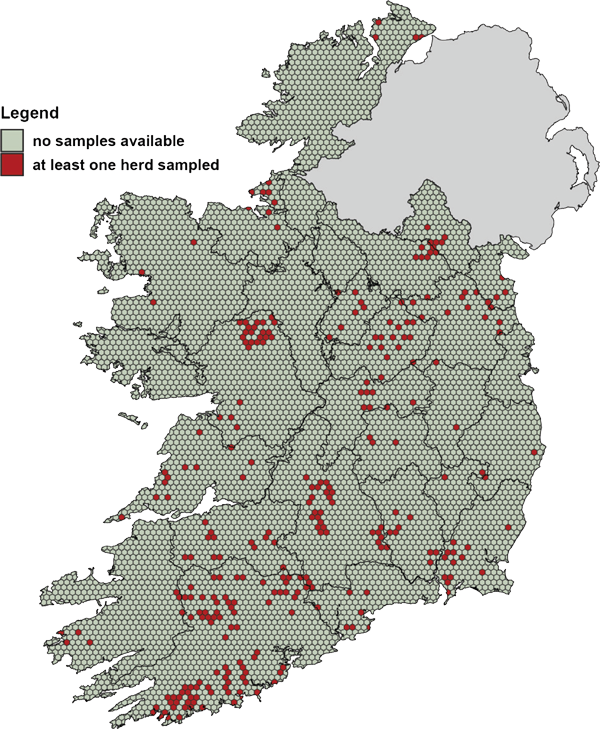
Figure 1: Map showing the spatial distribution of herds tested in the pilot.
Interpretation of YSCT results
If all animals in a given group are antibody negative, the check test for that group is considered negative, consistent with the absence of contact with a persistently infected animal in that cohort/herd. If one or more of the animals is antibody positive, this is possible evidence of exposure to the virus and the possible current or recent presence of a persistently infected animal in the herd. However, antibodies may also originate from vaccination or maternally-derived antibodies.
The Irish YSCT Pilot 2022
A young stock surveillance pilot took place during the autumn of 2022. It involved the sampling of herds at routine visits by trained BVD-TASAH vets. The main aims of this pilot were: to test the logistics for the implementation of young stock check test surveillance in dairy and beef herds; to commence the training and awareness for this type of BVD surveillance: to gain experience of the results generated; and to resolve any issues identified.
A total of 152 BVD-TASAH trained vets completed the YSCT Pilot 2022 training. A leaflet was produced to explain to farmers why the sampling was being done, how to access the results in ICBF, and how the results obtained through the pilot were not going to have any impact on the herd’s BVD status.
Participating herds
The map in Figure 1 shows the spatial distribution of the 342 herds that participated in the pilot. There was at least one sampled herd in each county except for counties Leitrim, Roscommon and Dublin. County Cork had most of the sampled herds.
The herd type distribution of participating herds was generated with the new herd classification model (Brock et al., 2022) as it can be seen in Figure 2. The majority of sampled herds (276, 81 per cent) were breeding herds (beef (B), dairy (D) or mixed (M)), with beef herds being most common.
The herd size ranged from 9 to 964, with an average and mean of 140 and 100 animals respectively. The mean size for beef herds was 72 animals, for dairy was 236, 64 for fattening, 180 for mixed, 64 for store and 44 animals for herds of unknown classification.
Animals
A total of 3,052 animals were sampled. Of these, the date of birth was known for 2,953 and the age distribution of these animals can be seen in Figure 3. The red dash lines indicate the 9 and 18 months which were the preferred age for sampling. In total, 1,023 animals (35 per cent of all tested animals) were not in the 9-18 months old age window.
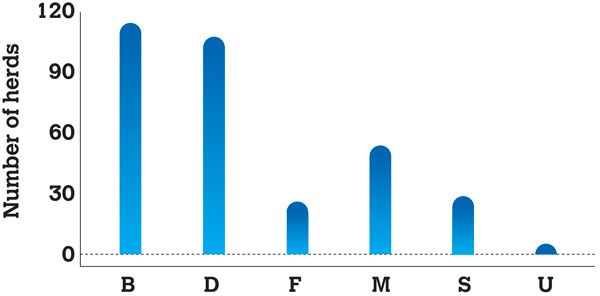
Figure 2: Herd type distribution. B: beef; D: dairy; F: fattening; M: mixed; S: stores; U: unknown.
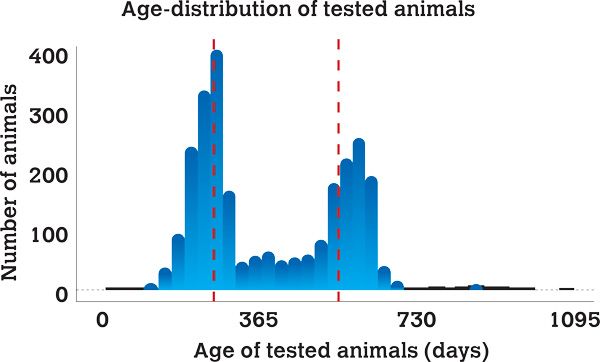
Figure 3: Distribution of 2,953 sampled animals by age in days.
Young stock groups
A total of 620 groups were tested in the 342 herds. On average 1.8 groups were tested per herd. The distribution of tested groups per herd over all tested herds is shown in Figure 4. Most commonly, a single group was tested.
BVD vaccination
At the time of writing this article, vaccination data had been collated for 215 herds. Only 16 (7.4 per cent) of these herds were actively applying a vaccination regime. 15 out of the 16 vaccinating herds were dairy and using an inactivated vaccine. The remaining vaccinating herd was a beef herd using a live vaccine.
Results
2.8 per cent of the animals tested positive for antibodies (Table 1). The age distribution of the 84 positive animals is shown in Figure 5. The distribution has the same structure as the overall distribution of all tested animals (Figure 3).
The 82 antibody-positive animals were found in 42 herds and 51 inconclusive animals were found in 34 herds. 27 of the 42 herds with positive outcomes had only one positive test result. In the 15 other herds with positive outcomes, at least two animals tested positive. In one herd, 15 positive animals were detected representing all animals in three separate groups. In this single herd, all tested animals were positive.
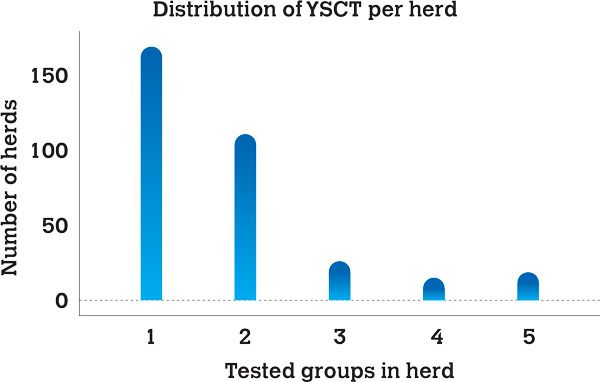
Figure 4: Number of young stock check test groups sampled per herd.
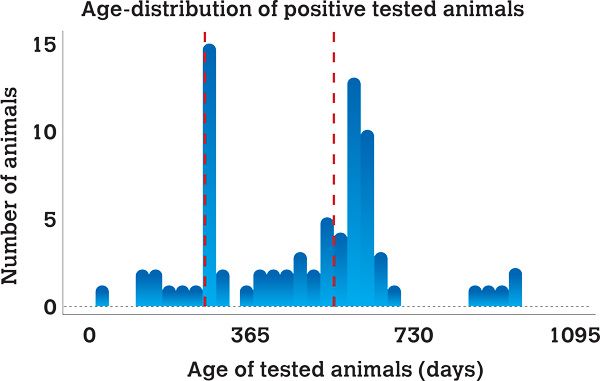
Figure 5: Age-distribution of the 84 antibody-positive animals.
Links to tag testing results
The 42 herds with one or more positive YSCT results were filtered by herd type. Only breeding herds were retained (n = 33) and these herds were linked to tag testing data ranging from 2019-2022. In six of the 33 positive breeding herds, BVD virus-positive animals were born between 2019 and 2022 and the positive result of the YSCT can be associated with a PI birth. These include the herd with the 15 seropositive animals in the 3 YSCTs, which had one virus positive calf in February 2022.

Table 1: Summary of test results by animal and by herd.
Vet survey
A survey was sent to all YSCT-trained vets. Sixteen vets who sampled between 0 and 35 farms each, responded. The majority (63 per cent) found the overall process easy or very easy. There was a range of responses on the keenness of farmers to participate, some being very reluctant and others keen to take part. There was also a range of responses regarding ease of identification of the animals and of the separately-managed groups. On this topic, vets commented that in some farms there were no animals of the preferred age available and some farms required considerable preparation as animals were placed in different locations. One vet also commented that it was difficult in herds with all year-round calving. 75 per cent of respondents answered that they felt sufficiently trained and did not need more practical experience, but some would have liked more insights to address different scenarios.
Conclusions
YSCT provides a way of monitoring herds for BVD. Animals of the preferred age range were not always available on farm. This could have an impact on false positive results at herd level if either older or younger animals were sampled. Most animals (95.5 per cent) and herds (78 per cent) were negative. This is not unexpected as the prevalence of BVD has reduced drastically in recent years. In addition, BVD suspect animals only remain on farm for a limited period of time (mean days from test result to removal is three in 2021 and 2022). Therefore, not in every farm with a suspect case will we see an antibody response. Before this type of surveillance is implemented more widely, it will be necessary to develop awareness campaigns both for farmers and vets. A key piece of information in order to correctly interpret BVD results is the vaccination history of the herds. Further analysis will take place, including gathering all the vaccination data and linking it to the antibody results.
Acknowledgements
We would like to thank all participating vets and farmers for their contribution to this study and the design of future BVD surveillance for Ireland. We would also like to thank the BVD National Reference Laboratory for testing the samples.
References
Brock, J., Lange, M., Tratalos, J. A., Meunier, N., Guelbenzu-Gonzalo, M., More, S. J., et al. (2022). The Irish cattle population structured by enterprise type: overview, trade & trends. Irish Vet. J. 2022 751 75, 1–11.
Houe, H. (1995). Epidemiology of Bovine Viral Diarrhea Virus. Vet. Clin. North Am. Anim. Pract. 11, 521.
1. A young stock check test will consist of:
A. Sampling a single young stock group
B. Sampling randomly selected animals
C. Sampling animals independently of the vaccination status
D. Sampling young, homebred, unvaccinated animals from each separately managed group
2. What is the proportion of herds with virus positive results that only had one virus positive animal detected?
A. 40 per cent
B. 60 per cent
C. 70 per cent
D. 90 per cent
3. Choosing younger animals for a YSCT:
A. Will give better sensitivity
B. May give a false positive result due to maternal antibodies
C. Would make the result invalid
D. All of the above
4. A positive BVD antibody result in an animal could indicate:
A. Recent vaccination
B. Maternally derived antibodies in young calves (including PI calves)
C. Possibility of carrying a PI calf in pregnant dams
D. Exposure to the BVD virus
E. All of the above
Answers: 1D; 2C; 3B; 4E.
















